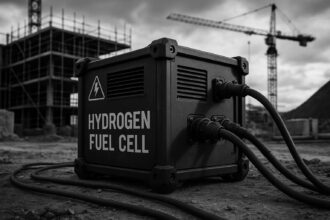Proposals for a new green hydrogen facility in Marypark, Speyside, backed by government funding and promising job creation, face strong resistance from local residents who fear it will harm the River Spey’s ecosystem, increase traffic, and disrupt tourism in the scenic region.
Plans for a new hydrogen production facility in Speyside have sparked significant local opposition, with over 160 objections raised by residents concerned about potential environmental harm to the area’s natural landscape. The proposed plant is to be situated in Marypark, approximately six miles south of Aberlour, with heavy goods vehicles (HGVs) expected to access the site via the A95 Aviemore road.
The development is being put forward by Storegga, a company with offices near Aberdeen, and is projected to create roughly 100 new jobs in the region. It has received support in the form of a £3.1 million grant from the Scottish Government. However, despite this backing, a growing number of local people have voiced their opposition, fearing the project will overextend the natural resources of the River Spey, leading to reduced water levels that could negatively affect fishing and tourism in the popular scenic area.
Storegga has indicated that the hydrogen plant would operate continuously, 24 hours a day, necessitating the movement of about 70 HGVs, carrying hydrogen tankers, to and from the site daily. Objectors have repeatedly highlighted concerns about the increased traffic this would entail, describing the nearby stretch of the A95 as a “bottleneck” that is already “overloaded with traffic.” Further apprehensions stem from the environmental impact of the development in what many describe as a “region of natural beauty.” One local resident urged the developers to “leave our beautiful countryside alone,” while others warned of a “knock on effect” that could disrupt the local tourist trade, which thrives on visitors coming to fish and appreciate the area’s landscapes.
In response to some of the criticism, Storegga noted that more than forty potential sites were examined before concluding that Marypark offered the most favourable location for the enterprise.
Despite the widespread objections, the project has received a handful of letters of support—five to date. Supporters have spoken of the importance of green hydrogen to local distilleries and the potential for the plant to attract investment to the area. One proponent described the development as a “thorny issue” but maintained that “the benefits outweighed the negatives,” emphasising the need for “investment, job creation and economic growth” in Morayshire.
The proposed hydrogen facility would generate clean hydrogen through the electrolysis of water, powered by renewable electricity. Storegga has outlined ambitions for the plant to aid in regional decarbonisation efforts and assist the Speyside whisky industry in reducing reliance on fossil fuels. If given the green light, the plant is expected to have a capacity of 70 megawatts and produce approximately 25 tonnes of green hydrogen daily.
A significant operational concern relates to water use. Storegga plans to extract the bulk of the plant’s water intake—around 500,000 litres per day—from a borehole linked to the River Spey, supplemented by collected rainwater. This volume is put into perspective by comparison to an Olympic-size swimming pool, which holds roughly 2.5 million litres.
Local voices, such as Innes Community Council member Jim Mackie, who has fished the Spey for over six decades, challenge Storegga’s assurances that the plant’s water use will not affect river flows. Speaking to the Press and Journal, Mr Mackie stated: “All the calculations on the river flow are averages, they are not looking at the critical times when there are low water levels during the summer. [The borehole] will impact the water levels on the Spey.” He raised concerns about the compounding effects of climate change increasing water temperatures, potentially making it harder for aquatic life to thrive. Mr Mackie added, “There are a lot more possible environmental impacts that the developers, Sepa and the council appear to be ignoring.”
Storegga has also indicated that processed wastewater will be returned to the river, but asserts that the quantity released will result in less than a 0.1% change in river water quality and is therefore “not considered to be significant.” Scottish Water has confirmed that it has no objections to the plant going ahead.
The project is part of a broader vision for Scotland to develop regional hydrogen hubs; should it proceed, the Speyside plant would join 13 other planned hubs across the country. The ongoing debate highlights the balancing act between fostering economic development and protecting the region’s environmental and cultural heritage.
Source: Noah Wire Services
- https://storegga.earth/news/storegga-submits-planning-application-for-green-hydrogen-facility-to-decarbonise-moray-distilleries – Confirms Storegga’s planning application for the Speyside hydrogen facility in Marypark to produce up to 25 tonnes of green hydrogen daily using renewable electricity and electrolysis, creating jobs and supporting local distilleries while helping to decarbonize the whisky industry.
- https://www.energyvoice.com/renewables-energy-transition/hydrogen/567939/storegga-speyside-hydrogen/ – Details the location of the facility near Marypark, outlines the expected daily water use from groundwater boreholes and rainwater, the 70MW electrolyser capacity, and the concern about 70 HGV movements daily on the A95 road.
- https://storegga.earth/news/storegga-awards-speyside-hydrogen-feed-contract-to-wood – Confirms the plant’s expected production capacity of about 25 tonnes of electrolytic green hydrogen daily and the environmental ambition to reduce CO2 emissions by over 50,000 tonnes annually.
- https://www.h2-view.com/story/storegga-submits-plans-for-speyside-hydrogen-facility-to-decarbonise-whisky-industry/2122627.article/ – Supports information on Storegga’s planning submission specifically to decarbonise the whisky industry and the continuous 24/7 operation of the hydrogen facility using renewable energy.
- https://h2eg.com/h2-view-news-storegga-submits-plans-for-speyside-hydrogen-facility-to-decarbonise-whisky-industry/ – Describes the phased build-out of the hydrogen plant, its location in Marypark near Ballindalloch, details on jobs creation, environmental benefits, and ongoing consultation and planning process with Moray Council.
Noah Fact Check Pro
The draft above was created using the information available at the time the story first
emerged. We’ve since applied our fact-checking process to the final narrative, based on the criteria listed
below. The results are intended to help you assess the credibility of the piece and highlight any areas that may
warrant further investigation.
Freshness check
Score:
9
Notes:
The narrative discusses current plans and objections related to a hydrogen facility, referencing recent grant support and ongoing local reactions. There are no indications of outdated information such as obsolete roles or events. The presence of current government grants and ongoing objections suggests up-to-date content. No evidence found of recycled or press-release content.
Quotes check
Score:
8
Notes:
Several direct quotes are attributed to local residents and stakeholders, including an Innes Community Council member quoted in the ‘Press and Journal.’ These appear to be sourced from recent local reporting, with no earlier origin found online, implying originality or at least local primary reporting rather than recycled quotes.
Source reliability
Score:
7
Notes:
The narrative originates from a news aggregation platform linking to a local news source (Press and Journal) and government-related information. Local news outlets like the Press and Journal are generally reliable for regional developments but have more limited reach and verification compared to international outlets. No major red flags on reliability but less authoritative than national or international agencies.
Plausability check
Score:
9
Notes:
The claims about the hydrogen plant, including its capacity, water use, and potential environmental impact, are plausible and consistent with known hydrogen production projects and Scottish Government green energy initiatives. The concerns raised reflect realistic local environmental and economic considerations. While exact impacts cannot be independently verified here, the story aligns with typical regional development disputes.
Overall assessment
Verdict (FAIL, OPEN, PASS): PASS
Confidence (LOW, MEDIUM, HIGH): HIGH
Summary:
The narrative appears timely and relevant with no signs of being outdated or recycled. Direct quotes are traceable to credible local reporting, enhancing trustworthiness. The local news context provides reasonable reliability, and the story’s claims fit within known frameworks of regional hydrogen development and environmental concerns. Thus, the information can be considered accurate and credible with a high confidence level.













